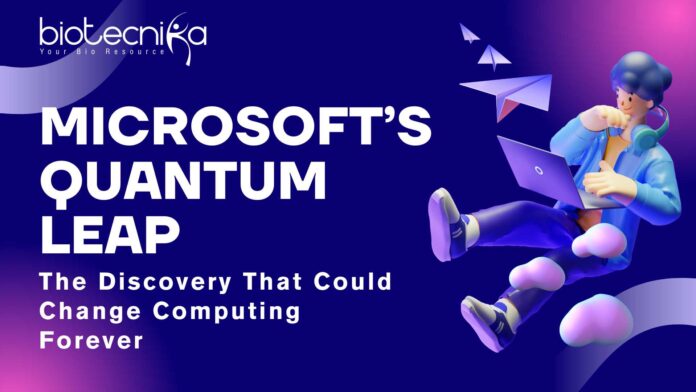Microsoft’s Quantum Leap: The Discovery That Could Change Computing Forever
A New Era in Computing?
In a revelation that could shake the foundation of modern computing, Microsoft has announced a breakthrough that might bring us closer to the long-elusive dream of practical quantum computing. The company claims to have discovered a new state of matter that could revolutionize industries, accelerate scientific discovery, and even create unhackable networks.
If you thought the emergence of AI was the pinnacle of technological advancement, then think again. Quantum computing is all set to be the real game-changer. Microsoft’s latest development puts it in direct competition with tech giants like Google, IBM, and Intel in the competition to build the first commercially viable quantum computer.
But what does this mean for the world? How does it work? And why are some experts skeptical about Microsoft’s bold claim? Let’s break it down.
The Quantum Computing Race: Microsoft vs. Google vs. The Universe
The world has been buzzing with quantum computing for years, but progress has been slow. Classical computers use binary bits (1 and 0), while quantum computers use qubits, which can exist in multiple states simultaneously. This allows them to perform computations at a rapid speed.
Google made headlines in 2019 when it claimed “quantum supremacy”—achieving a calculation in minutes that would take a classical supercomputer thousands of years. Then, in December 2023, Google turned up the heat again with an experimental quantum machine that allegedly outperformed classical supercomputers by a margin so vast it would take the universe longer than its entire lifespan to match the results.
Now, Microsoft has responded with what could be a quantum leap ahead of the competition—a new kind of qubit called a topological qubit, built using an entirely new phase of matter. The company believes this approach will create a quantum computer that is not just powerful but also stable, which has been one of the biggest challenges in quantum computing.
How Does Microsoft’s New Quantum Technology Work?
Qubits vs. Topological Qubits: A Game-Changer?
One of the significant difficulties in quantum computing is error rates. Qubits are highly unstable; even the slightest disturbance (like a tiny change in temperature or electromagnetic interference) can be the reason to lose their quantum state. This is why quantum computers must operate at extremely cold temperatures—colder than outer space.
Microsoft’s topological qubits aim to solve this instability issue. Here’s why they’re special:
- They rely on “knotted” quantum states that are more resistant to external noise and interference.
- Unlike regular qubits, which store information like writing in sand, topological qubits store data like knots in a rope—resilient and robust even when the system is disturbed.
- Microsoft’s new chip combines semiconductors (used in classical computers) with superconductors (used in quantum computers), potentially merging the best of both worlds.
This could mean faster, more efficient, and error-resistant quantum computing, giving Microsoft a serious edge in the quantum race.
The Challenges: Is Microsoft’s Claim Too Bold?
While Microsoft’s breakthrough sounds like something straight out of a sci-fi novel, the scientific community remains cautiously optimistic.
- Microsoft has only built eight topological qubits so far—nowhere near enough to perform meaningful quantum calculations.
- Some physicists are skeptical about whether topological qubits will scale as Microsoft hopes.
- Even with this progress, building a practical fault-tolerant quantum computer could still take years, if not decades.
But Microsoft remains confident. Chetan Nayak, the Microsoft technical fellow leading the project, claims this new approach could put commercial quantum computing within reach within years—not decades.
How Quantum Computing Will Change the World
The implications of quantum computing are mind-blowing. If Microsoft succeeds, its quantum computers could transform industries and solve problems that today’s supercomputers can’t even begin to tackle.
1. Drug Discovery & Personalized Medicine
Quantum computing might be able to simulate and predict molecular structures at an atomic level and help in accelerating drug discovery. It could lead to new cures for diseases, personalized medicine tailored to your DNA, and even breakthroughs in anti-aging research.
2. Climate Change & Energy Solutions
Quantum computers can structure intricate chemical reactions, permitting for enhanced solar panel designs, the development of next-gen batteries, and the optimization of carbon capture technologies. It enhances our fight against climate change.
3. Unhackable Cybersecurity & Quantum Internet
The concept of unhackable networks is particularly thrilling. Quantum encryption could render data breaches nearly impossible, safeguarding everything from personal details to national security secrets.
4. AI advancement
AI has significantly transformed our lives, yet quantum AI promises to elevate this change. With capabilities like real-time language translation and autonomous robotics that can process information at an unprecedented scale. Quantum AI could render today’s deep learning models seemingly outdated.
5. Revolutionizing Materials Science & Manufacturing
Quantum computing may enable the creation of self-repairing materials. Envision bridges, airplanes, and smartphone screens that mend after sustaining damage.
6. Tackling Plastic Pollution
Quantum simulations may facilitate the development of enzymes that decompose plastics and pollutants into valuable byproducts. Tackling one of the globe’s significant environmental challenges crises.
Microsoft’s Quantum Leap
Quantum Computing Explained in Everyday Terms
For those who don’t have a PhD in physics, here are some easy-to-understand analogies:
- Quantum Computers Are Like a Vault with a Million Keys
- A classical computer tries one key at a time.
- A quantum computer tries all the keys at once.
- A Quantum State Is Like a Blurry Photograph
- Before you focus the camera, the image is unclear, with many possible outcomes.
- When you snap the photo, only one possibility remains—just like how measuring a quantum state forces it into a single outcome.
- A Qubit Is Like a Spinning Coin
- A classical bit is like a coin that is either heads (0) or tails (1).
- A qubit is like a spinning coin—both heads and tails at the same time until it’s observed.
- Superconductors Are Like Moving Walkways
- When you walk on the ground, there’s friction.
- A superconductor is like a frictionless walkway—allowing electrons to move without resistance, making them perfect for quantum computing.
- Topological Qubits Are Like Knots in a Rope
- Regular qubits store information like writing in sand—it can be erased easily.
- Topological qubits are like knots in a rope—even if you shake or move the rope, the knot remains intact.
The Final Word: A Future Closer Than We Think?
Microsoft’s discovery of a new state of matter might be the missing piece of the puzzle in quantum computing. Although it is still in the developing phase, we are getting closer to gaining quantum supremacy every day.
But will it live up to the hype? Will Microsoft outpace Google and IBM? Or will this be another over-promised, under-delivered technology?
One thing is sure: the next few years will be crucial, and the company that wins the quantum race could define the future of computing for generations to come.
Get ready—because the quantum era is coming.
Microsoft’s Quantum Leap: The Discovery That Could Change Computing Forever






























